Originally meaning male bee, which dies after fertilising queen bee mid-air, the term drone was first applied to aircraft in 1935 in form of DeHavilland DH82 Queen Bee, a remote controlled fixed wing aircraft variant used for target practice (and hence dying after performing its duty).

On the quest to create practical rotary wing aircraft, designs with differing number of rotors were considered, including single rotor (helicopter), twin rotors (bicopter), quadrotor/quadcopter, or even more rotors (termed collectively as multicopter). Helicopter design prevailed earlier with mass production of Sikorsky R-4 in 1942. Helicopters are cool for boys, so starting from 1969, Dieter Schlüter produced 1st remote-controlled model helicopter kit, powered by methanol Internal Combustion Engine (ICE). His invention expanded the aeromodelling hobby from just fixed-wing model aircrafts to include rotary-wing model aircrafts too. The aeromodelling field gave birth to few niche component suppliers, such as mini diesel engine producer, etc. In time, model helicopter with electric propulsion would appear, such as the Ishimasa EH-1 in 1980.
Helicopters and quadcopters/multicopters have very different flight control mechanisms. In helicopters, altitude change is done by changing the angle of attack (AoA) of all rotor blades collectively, while horizontal movement is done by tilting the blade assembly toward the direction of movement. All the while, the tail rotor of helicopter must balance out the angular momentum created by the rotation of the main helicopter blades in order to prevent rotation of the fuselage (which would make the pilot very airsick). Adjusting the speed of the tail rotor will allow angular momentum imbalance that results in the helicopter turning the direction it's facing. In quadcopters/multicopters, altitude change is done simply by adjusting the rotational speed of all rotors, while horizontal movement is done by increasing the speed of the rotors on the opposite side of the desired direction while decreasing the speed of the rotors on the side of the desired direction. Varying the speed between adjacent rotors will cause angular momentum imbalance that results in the quadcopter/multicopter turning the direction it's facing.
Early models
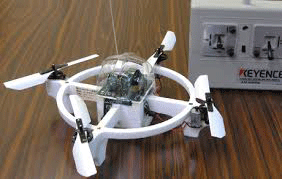
First toy quadcopter named Gyrosaucer was produced by Keyence from Japan in 1989. It used electric propulsion powered by Nickel-Cadmium (NiCad) battery (which has lower energy density than Lithium-ion battery that Sony would only start mass-producing 2 years later) and hence could only fly for less than 3 minutes at a time. Its propellers and fuselage were made from fragile styrofoam to make it as light as possible and maximise flight time, but would be easily damaged should it make contact during flight. This, however, showed how fully electronic flight control system is possible with quadcopter design, whereas helicopter flight control system will still need mechanical control to tilt the rotor and blades. Keyence would follow this up with launch of Gyrosaucer II in 1991 and GS III in 1995.
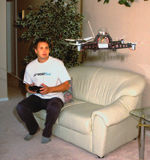
In 1999, Zenon Dragan’s Draganfly released the $697 Draganflyer quadcopter kit, which could already be equipped with optional small black & white 900 MHz wireless live video camera. It was still powered by NiCad battery (flight time about 5 minutes) since Li-ion battery was more expensive. Draganfly would follow this up with launch of Draganflyer II in 2000, Draganflyer III in 2001 (with optional $299 colour wireless live video camera), Draganflyer IV in 2004 (with Lithium polymer battery for 13-17 minutes flight), Draganflyer V Ti in 2005, and Draganflyer SAVS in 2006 (where the camera is mounted away from the fuselage with vibration dampening material to reduce the jello effect in the resulting video).
New generation of players joined in
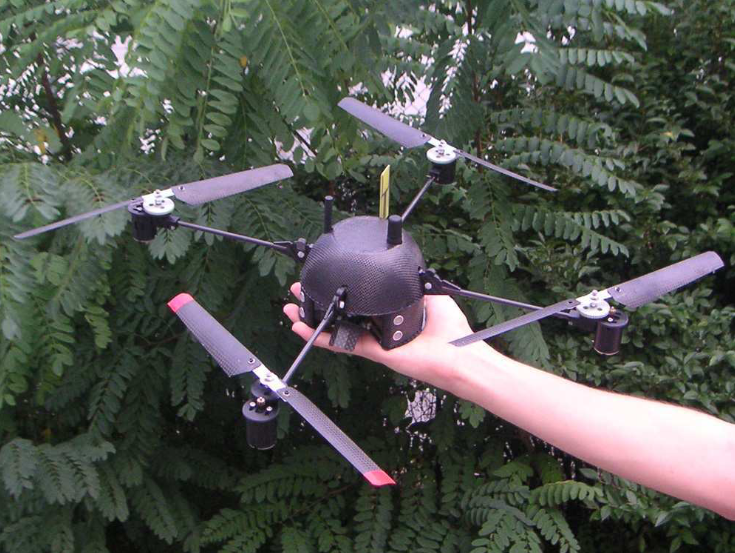
In another continent in 2005, student team from Institut National Polytechnique de Grenoble (INPG) led by Pascal Zunino won 1st prize at international aerial robotics competition held by Direction Générale de l’Armement (DGA) & Office National d’Études et de Recherches Aérospatiales (ONERA) at Mourmelon military camp with their CPX4 quadcopter. The next year, Pascal founded Novadem to sell drones.
Meanwhile, with China’s rise as factory of the world, cheap electric toy helicopters from there started to be exported all over the world by companies like Syma (which also made remote-controlled toy cars and boats). Still in 2006, Frank Wang (汪滔), a long-time model helicopter hobbyist and graduate student at Hong Kong University of Science & Technology (HKUST), started selling the prototype of GPS-stabilised model helicopter flight control system he made during his graduate study research for about $7,500 on RCForum.net. With GPS (Global Positioning System) stabilisation, the model helicopter using his flight control system can automatically try to hover (maintain its position in the air) as per the 3 axis coordinate calculated from GPS satellite signals when there’s no command to move, making it much easier to fly for beginner hobbyists. When he found that there were real demand for his prototype, he founded Da Jiang Innovation (DJI) in the same year to commercialise his product.

Beside Frank Wang, other people were also trying to make their own model aircraft flight control systems. Chris Anderson, editor of Wired technology magazine, had been making his own flight control system for fixed wing model aircrafts using used HP iPaq PDA (Personal Digital Assistant) and Lego Mindstorm NXT computer since 2007. He started on-line community around this hobby in the same year by creating DIYDrones.com. He met a young immigrant engineer named Jordi Muñoz there the next year, who made his own model helicopter flight control system using the open source programmable microcontroller Arduino and sensor from Nintendo Wiimote. Together, they founded 3D Robotics to commercialise their passion. DJI’s first finished product, the $3,899 XP3.1, was released in the same year, and was the world’s first commercial GPS-enabled model helicopter flight control system. At the same year in Germany, another start-up called Mikrokopter complemented its multicopter flight control system (named simply FlightCtrl) from the year before with GPS capability, probably the first in the world to be able to do so for multicopter. Its complete package including GPS & magnetometer/compass was around $800. Meanwhile, 3D Robotics’ first product, an Arduino-based fixed wing flight control system called ArduPilot (with GPS module connector), was released for $24.95 the next year.




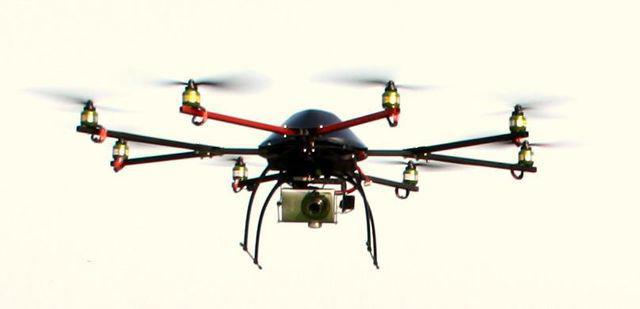
In 2008, Draganfly released its first GPS-stabilised hexacopter with folding arms, the $14,995 Draganflyer X6. With 6 propellers, it can tolerate loss of one motor by turning off another functional motor and continue to fly normally as quadcopter. The folding arms also made it easier to transport the hexacopter. It featured optional remotely-tiltable camera mount under the fuselage. The next year, Draganfly released a cheaper model, the roughly $9,000 Draganflyer X4 quadcopter. Mikrokopter also followed up its previous year’s release of Almost Ready-to-Fly (ARF) $1,190 quadcopter kit with $1,535 MK-Hexa hexacopter kit & $2,045 MK-Okto octocopter kit this year. Wanting to offer cheaper quadcopter alternative, Ted Carancho began testing his own quadcopter called MikroQuad powered by his own Arduino-based open source flight control system still in 2009. He would change the project name to be AeroQuad later in the year.
DJI released its improved flight control system, the around $3,500 AceOne, in 2009. In the same year, 3D Robotics’ people helped make ArduPilot’s companion product: ArduIMU. Jose Julio tried to make quadcopter prototypes using ArduIMU the next year, including a prototype with ultrasound range-finder for maintaining its altitude indoor, but later in that year, it was announced that AeroQuad team will be joining forces with with the ArduPilot community in quadcopter development called ArduCopter. The joint development will be based on 3D Robotics’ improved flight control system released later in the year called ArduPilot Mega (APM), selling for $208 including IMU (Inertial Measurement Unit) module. The resulting ArduCopter kit would be marketed toward the end of the year at $595 excluding remote control transmitter & receiver as well as battery. Draganfly would also update its line-up for the year by introducing $39,670 Draganflyer X8 octocopter with foldable arms capable of lifting heavier DSLR (Digital Single Lens Reflex) cameras.
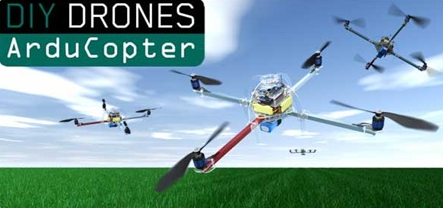
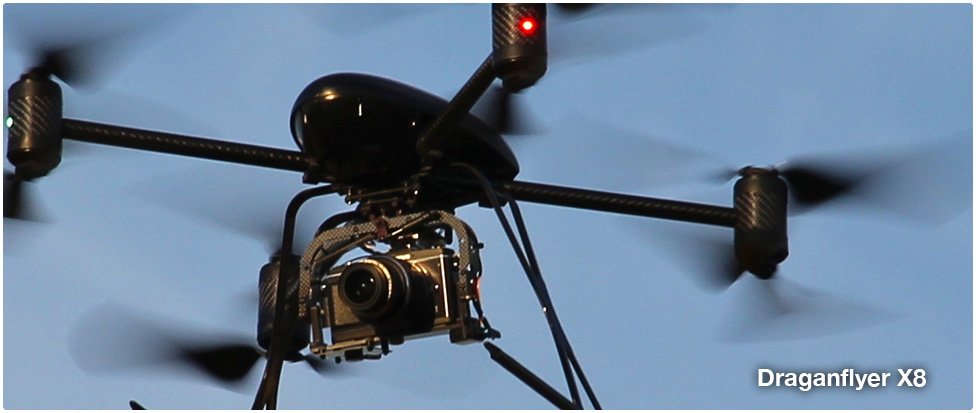
By the way, still in 2010, Alexandre Dubus also developed flight control system on Arduino connected to PCB (Printed Circuit Board) that’s been removed from Wiimote, similar to the way Jordi Muñoz did it 2 years before. He called it MultiWii and gave it away as open source. It didn’t have GPS connectivity like the ArduPilot or APM custom boards, but provided cheaper alternative for those who liked to make their own DIY (Do It Yourself) drones.
Mainstream interest started
In 2010, Parrot, a French consumer electronics company specialising in Bluetooth equipments, launched a new product line to diversify its business: a $299 Wi-Fi controlled quadcopter called AR.Drone. It had been under secret development for 3 years spearheaded by the founder himself, Henri Seydoux, with assistance from Novadem. It imagined a completely different use case for quadcopter; a toy that is safe to fly indoor, with camera that can be monitored via smartphone, and whose flying direction is controlled by the tilt of the connected smartphone. Its price point and ease of use attracted wide-spread public interest. To make it safe indoor, its propellers were surrounded by protective Expanded Polypropylene (EPP) foam. It also featured ultrasound range-finder to for indoor altitude-hold.
Both DJI and 3D Robotics updated their flight control system in 2011. DJI released 2 variants of its latest flight control system: $1,300 Wookong-H for helicopters and $1,099 Wookong-M for multicopters. Clearly, DJI was feeling the pinch from the semi open source nature of 3D Robotics approach, even though many clearly thought DJI had superior product. The same year, 3D Robotics released $199 ArduPilot Mega 2.0 (APM 2). The Arduino architecture used as basis for APM 2 clearly had limitation in term of processing power however, especially as more sensor inputs were fed into flight control system and additional peripherals were needed to be controlled such as camera mount. Thankfully Lorenz Meier were leading separate team in perfecting the Pixhawk flight control system hardware & software he made during his studies at ETH (Eidgenössische Technische Hochschule) Zürich. By 2012, the 4th iteration of Pixhawk was mature and was released together by Lorenz Meier & 3D Robotics as $238 PX4 (consisting of flight management unit & input/output module).
Up to this time, the available drones had been sufficient for surveillance or maybe amateur aerial photography purposes. Hollywood saw the potential of replacing expensive shots from real helicopters with cheaper ones shot using drones. Problem was there had been no drone big enough to carry serious Hollywood cameras. Sure, Draganflyer X8 could carry DSLR cameras, but that was just moderately priced toy camera compared to what Hollywood used. Red Epic camera, for example, would cost $39,500! When Mikrokopter enlarged their kits in 2011, a new company called Freefly worked with Mikrokopter’s US distributor called Quadrocopter.US to release a new serious film-making drones capable of carrying Red Epic with 2-axis gimbal. It came in 2 variants: the $8,502 Cinestar 6 hexacopter and $9,890 Cinestar 8 octocopter (both prices for basic configuration without gimbal). Both were still powered by Mikrokopter’s FlightCtrl.


Meanwhile, the DIY drone community was going strong. Since components like battery, motor, ESC (Electronic Speed Control), and propellers were carried over from other forms of aeromodelling aircrafts, what’s left is supplying multicopter frames. Tim Nilson, who founded FPVManuals.com & GetFPV.com, stepped up and produced its 1st quadcopter frame in 2012, the $189 QAV500. The Arduino limitation was also noticed by the community around MultiWii open source flight control system. So that year, a mysterious person by the name of Hamasaki ported MultiWii to more powerful STMicroelectronics STM32F1 microcontroller, named the ported flight control system BaseFlight, and released a custom board for it called Naze32, while still maintaining the open source nature of the project. It was selling at much cheaper price of ¥5,000 (around $62 at the time) and still didn’t have GPS stabilisation.

2012 was a busy year for DJI. It was getting serious with vertical integration. It released a hexacopter ARF kit called Spreading Wing S800 for $1,900, to be paired with its Wookong-M flight control system. It also released a camera mount with active stabilisation (i.e. gimbal) across 3-axis of movement for the S800 kit, the $3,500 Zenmuse Z15, capable of carrying compact cameras. Aside from those, it released lower cost flight control systems, $290 Naza-H for helicopters and $240 Naza-M for multicopters, both can be paired with $160 Naza GPS module. And finally, it released 3 choices of ARF kits named Flame Wheel for Naza-M: F330 quadcopter, $190 F450 quadcopter, and $318 F550 hexacopter. 3D Robotics also updated its ArduCopter line-up this year by upgrading its $449 quadcopter and adding $549 hexacopter model.
Another major development happening in 2012 was the entrance of the toy helicopter players into toy multicopter field, encouraged by the market acceptance of AR.Drone. Some of the more innovative toy helicopter producers which introduced their 1st toy multicopter this year are Hubsan from Dongguan as well as UDI & Syma from Shantou. Hubsan’s offering this year was $45 H107, UDI’s was $48 U816, while Syma’s was $45 X1. They will soon be joined by dozens of other toy brands from the country in flooding the global market with cheap multicopters.



DJI completed its vertical integration in January 2013 by releasing its 1st complete Ready To Fly (RTF) package called Phantom for $679. Unlike its bigger sibling S800, Phantom didn’t come with camera. Instead, it provided simple camera mount for the popular action (hence light) camera, GoPro. But 3D Robotics wasn’t standing idle. Later in the year, their collaboration with Lorenz Meier’s team released their newer next generation flight control system called Pixhawk for $199. 3D Robotis then used Pixhawk to power their 1st complete Ready To Fly (RTF) package called Iris for $730. From the get-go, Iris had few advantages compares to Phantom. It could be controlled via Android app (a la AR.Drone), and given that the Android tablet/smartphone was equipped with GPS receiver, Iris could actually follow the pilot around, which would be cool when camera like GoPro was mounted on it. Its Android app could even be used to give pre-programmed flight route for the Iris (i.e. waypoint). Moreover, toward the end of the year, 3D Robotics announced the availability of its $219 Tarot 2-axis (pitch & roll) gimbal for Iris. It didn’t smooth out the yaw movement like Zenmuse Z15, and could only carry lighter cameras like GoPro, but it cost so much less! DJI was startled at how its initial RTF launch could’ve been upstaged so quickly, and hurriedly launched 2 newer Phantom versions within the same year; $1199 Phantom Vision with built-in camera that could connect to its smartphone app, and Phantom 2 Vision with longer flight time later for the same price. It also released its simpler $700 2-axis action camera gimbal called Zenmuse H3-2D for Flame Wheel and Phantoms. By the end of 2013, DJI & 3D Robotics were climbing over each other to be crowned the king of consumer photography drone, and the world for the first time had relatively affordable machines to shoot decent aerial videos with.


Fast product launch cadence was not only the domain of photography drones in 2013. It also happened on the toy drone segment. Hubsan released 2 updates to the previous year’s H107: the H107C with camera and the H107D whose transmitter had LCD screen for live-streaming the camera feed to the pilot. UDI updated its previous year’s U816 with U816A this year, now sporting built-in foam propeller guard a la AR.Drone. And before the year ended, UDI released a follow up, the U817A, this time with basic camera that could record photo/video. Syma updated the look of its product line with X3. By this time, there were already few more toy producers entering the toy multicopter segment that it became hard to keep track of all of the players in this segment.





Others started to see the potential for drone to be used on other purposes than aerial photo/video. Toward the end of 2013, Amazon announced that they were researching using drone for order delivery. It would take a long time before this would even get close to large scale application. The challenges are too numerous. Chief of all: how to do autonomous collision avoidance when the sky are littered with other drones, kites, tall trees, high voltage electricity transmission lines, not to mention high-rise buildings. Then when it comes to descent for delivering the package at street level, how to autonomously avoid hitting children playing in the yard with bicycles, overhead power lines, garden shrubs, mailbox, parked cars, etc. On top of that, there’s great concern with form factor; it’s easier to drop package at the address using multicopters, but multicopters have much shorter flight range than fixed-wing drone. Fixed-wing drone, on the other hand, may have much longer flight range, but can only drop non-fragile packages from above since most addresses don’t have enough space for landing & take-off.
A side note to 2013; Freefly used their drone gimbal knowledge to create a compact handheld gimbal for cameramen, the $15,000 Movi 10. It was received very well by film-making community, the core customer segment for Freefly, as it was much smaller than the trusty Steadicam which required the cameraman to wear harness.
Competitors piling in
DJI updated its line-up in 2014 by introducting $1,299 Phantom 2 Vision+, this time with camera built directly into its 3-axis gimbal. It also released a more professional film-making drone with dual controller capability (pilot+cameraman), a rotating 4K camera, skids that automatically retract upon take-off so as not to block the camera view in-flight, and faster flight speed (good for filming chase scene). It’s aptly called Inspire 1 and cost $2,899. If that’s not enough for demanding film-makers, DJI also released Spreading Wing S900 hexacopter ARF kit for $3,490 as well as its bigger brother the S1000 octocopter for $3,940. The S900 & S1000 could carry DSLR camera with its Zenmuse gimbal, and also came with skids that automatically retract upon take-off. Following Freefly’s step, DJI released a handheld version of its Zenmuse Z15 called Ronin. Parrot decided to up its game this year by releasing $499 (for smartphone control option, transmitter is $400 extra) Bebop, adding in GPS stabilisation but relying on Electronic Image Stabilisation (EIS) for its video recording instead of putting on gimbal. Yuneec, once a toy helicopter manufacturer which has shifted to making electric paraglider, came back to remote controlled aircraft field this year in big way. It started by exhibiting the $2,999 HX3 hexacopter prototype with 2-axis gimbal capable of carrying DSLR, but decided not to pursue it. Instead, it first released the $1,299 Q500 quadcopter with 3-axis gimbal and built-in camera, with obviously comparable price & capability to Phantom 2 Vision+. It also announced that the $4,999 H920 hexacopter with 3-axis gimbal capable of carrying DSLR will be available starting from the next year. Obviously, this rather new field is getting crowded fast.





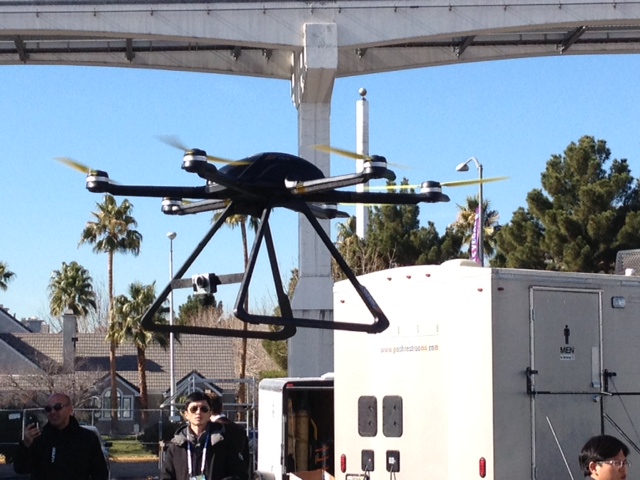


The toy segment was also moving fast. UDI set aside the U817A part number it used the year before for domestic Chinese market and designated all export of the same product as U818A. Aside from updating its X3 to X4, Syma also experimented with squished Phantom look-alike with X5 (this shape proved popular) and its camera carrying variant X5C, as well as a larger drone called X6 that could lift GoPro. Hubsan had bigger ambition: they announced they would make drone as good as Phantom the next year.


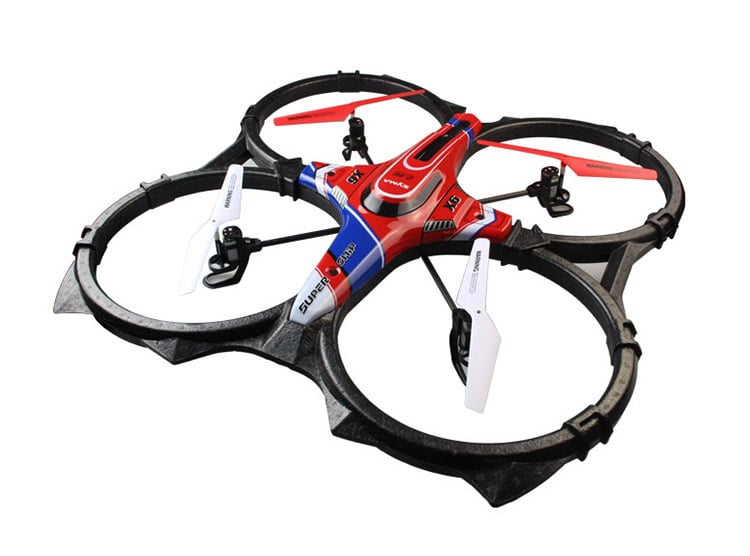
By this time, the DIY drone community had pretty much given up on trying to make photography drones themselves. They’ve instead focused their effort on creating fun drones for acrobatic purposes or racing. And for that, flight control system with less stabilisation is actually better. The same reason why professional racing driver turn off traction control system. One last side note for 2014 was that Dominic Clifton lead a team who forked the open source BaseFlight flight control system into a newer open source project called CleanFlight that supported other more powerful custom flight controller boards.
In 2015, Freefly renewed its film-making drone offering by releasing the $8,495 Alta 6 hexacopter. It had camera mounts on top as well as at the bottom. Mounting camera on top of the drone would be useful for shooting cinematic footage while flying underneath a bridge or footage of ascending a cliff, for example. This time, Freefly used Synapse as its flight control system. DJI chose unique strategy for its Phantom line-up in 2015. It released models with many improvements like $999 Phantom 3 Advanced & $1,259 Phantom 3 Professional, but it also tried to reach down-market by launching only slightly improved model with $699 Phantom 3 Standard. Pretty much like how IBM launched PCjr to reach down-market in 1984, but much better executed. It also launched programmable $3,299 Matrice 100 for those who needed to customise their own drones (for example, it had collision avoidance built-in) as well as $15,000 Agras MG-1 agricultural drone. And lastly, DJI released handheld version of what seemed to be Inspire’s gimbal & camera assembly and called it Osmo. 3D Robotics also launched their next generation $999 Solo drone this year. Just like the case with Iris, its gimbal was not available at launch date, and when it was finally available, it didn’t perform well enough. Coupled with Chris Anderson’s overly high sales forecast causing excess Solo inventory, it resulted in financial difficulty for 3D Robotics, and crippled a formidable DJI’s competitor. Many established corporations wanted piece of the action in this red-hot field, and this year, Intel made $60m investment in Yuneec. An interesting development this year was Hubsan, which had only been making toy quadcopter, managed to produce a GPS-stabilised drone with 3 axis gimbal and cool transmitter to compete with the big boys. It’s called H109S and priced at $879.





On the toy drone segment this year, Syma upgraded its X5C camera with Wi-Fi connectivity and smartphone app and released it as X5SW. It also changed the shape of its larger drone to look more like Phantom (just like its smaller X5 line) and released it in 2 variants: X8C without Wi-Fi connectivity and Wi-Fi enabled X8W. Drone racing was starting to become serious business this year. Boris Bnow forked the open source flight control system Cleanflight into a new project called Betaflight this year, and it soon became racers’ favourite.
A new entrant became very famous this year: Lily. It’s supposedly a $999 drone that only needed a simplistic 5-buttons remote control (equipped with GPS receiver), could start flying by itself once it detected that it’s free-falling (after being thrown into the air), and will automatically follow its user who’s holding that remote control, and was water-proof. Problem was, at that price, it could only shoot non-stabilised 1080p video, while the similarly priced Phantom 3 Advanced released this year could shoot stabilised 2.7K video. There was a huge pre-order discount, so tens of thousands pre-orders came in. Bringing the promised product capabilities to reality would turn out to be challenging, but it would take a couple of years for that to unfold.
Near-monopoly established
In 2016, Freefly released a bigger brother to its previous year’s film-making drone, the nearly $18,000 Alta 8 octocopter. This year, Yuneec released its $1,799 Typhoon H film-making hexacopter as well as a strange cheaper drone called Breeze for $499 which only came with EIS (a la Bebop). The same year, Xiaomi, the Chinese smartphone brand, through its affiliate company called Fimi, released Mi Drone in 2 variants: $460 for 4K & $380 for 1080p. Though feature-packed and attractively-priced, Mi Drone didn’t get massive global sales because Fimi could only sell it through Xiaomi’s distributors, and Xiaomi’s distributors in most countries didn’t carry Mi Drone. Hubsan, using knowledge gained by releasing H109S, released a cheaper GPS-stabilised drones with no gimbal, the $349 H501S as well as its little brother the $179 H502S, which sold quite well. Syma updated its offering with barometer for automatic altitude-hold, and UDI will spend the year catching up to Syma in terms of technology.






From being the dominant drone camera provider in 2013 to seeing the prospect of 3D Robotics, its only strong supporter left in the field, withering, GoPro decided to make its own drone in 2016. It’s amazingly portable, with folding arms that made it possible to easily store it in backpack, and with gimbal that could be removed from the drone to be used as handheld gimbal (a la Osmo). Nick Woodman, GoPro’s founder, chose to call their drone $999 Karma because DJI didn’t want to develop drone for them according to his whims. The product launch was highly anticipated and great to watch.
Unfortunately for GoPro, aside from releasing $1,399 Phantom 4 with collision avoidance and updating its film-making drones with $2,999 Inspire 2 & $4,599 Matrice 600 earlier in the year, DJI had also prepared an even more astonishing next product. And it revealed it within 2 weeks of Karma’s launching. It’s also foldable, but considerably smaller than Karma. The amazing part was its mini gimbal, much smaller than anything else on the market at that time. And it had also inherited collision avoidance! The product was named Mavic, and was priced at $999. Those factors alone should’ve ensured Mavic’s win over Karma. But when Karmas’ battery started sliding out mid-flight for many users, Karma’s fate was sealed. From this point on, DJI can be said to have near-monopoly. After fending off 2 major contenders, those who were left in the field couldn’t mount meaningful challenge to DJI after this. Maybe they could try to fight on price, but that wouldn’t amount to a dethroning maneouvre.
